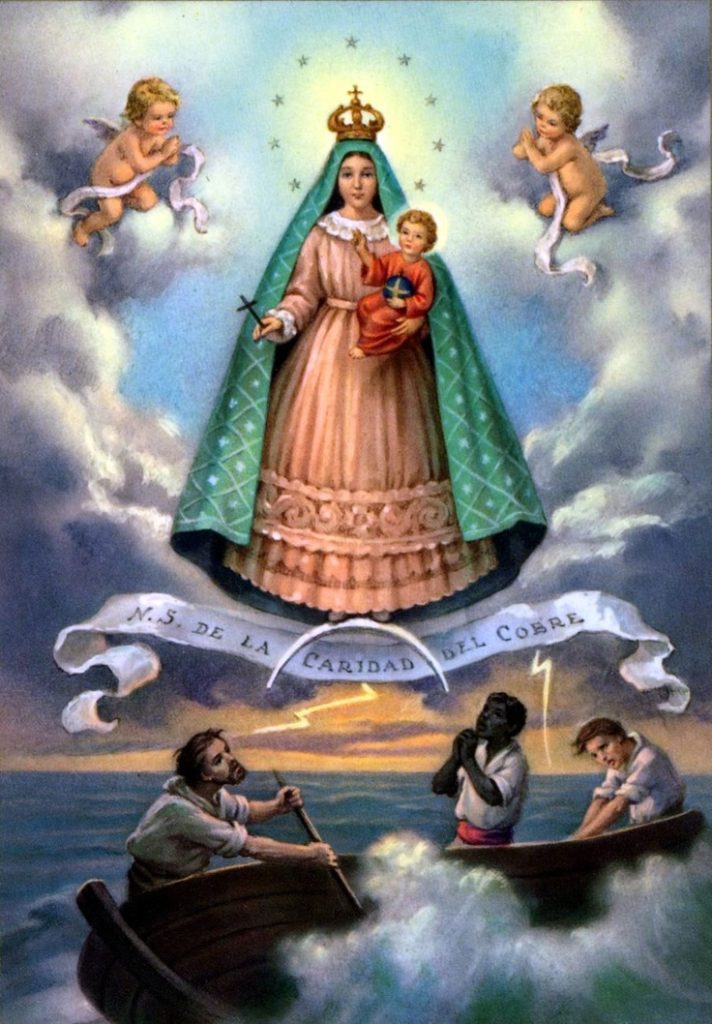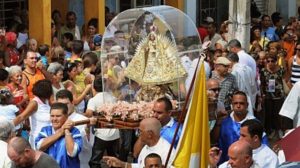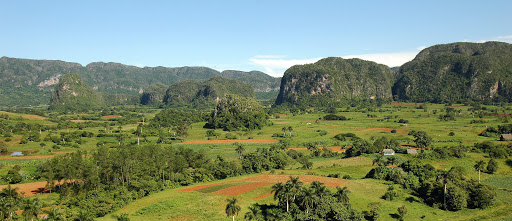LA VIRGEN DE LA CARIDAD DEL COBRE DE CUBA O SIMPLEMENTE “CACHITA” EN LOS HOGARES CUBANOS
La Virgen de la Caridad del Cobre es la patrona de los cubanos. Algunos la conocen simplemente como la Caridad del Cobre o ‘Cachita’.
Desde tiempos inmemorables en cada hogar de Cuba se puede ver un cuadro o una reliquia con la imagen de la virgencita. La imagen representa la Virgen María con un Niño Jesús en sus brazos y un bote con tres personas en un mar picado.
Es destino de la peregrinación de miles de creyentes que acuden diariamente a venerar la virgen e implorar sus favores y bendiciones, especialmente el día 8 de septiembre, día de la virgen es inmensa la cantidad de personas que acuden desde todas partes de Cuba a rendirle homenaje, en particular yendo a pie desde Santiago de Cuba, distante unos 20 kilómetros de esa cuidad y en camino con numerosas elevaciones, aunque durante todo el año los fieles acuden al Santuario del Cobre.
 VIDEOS- VIRGEN DE LA CARIDAD DEL COBRE.
VIDEOS- VIRGEN DE LA CARIDAD DEL COBRE.
Su nombre se debe a que fue construido al borde de una existente mina de cobre en aquel entonces. Muchos fieles y no fieles realizan la peregrinación, muchos buscan en la Patrona de Cuba, apoyo espiritual y la solución de sus problemas y se realizan promesas comúnmente encaminadas a la curación de seres queridos. La mayoría de los visitantes al Santuario se llevan consigo pequeñas piedras de la mina del cobre, donde se ven brillar las partículas del mineral. Estas se conservan en el hogar en vasos de agua, bolsos o se llevan consigo en la ropa, como protección eficaz contra los males y como un talismán de luz y buena suerte.
La imagen original de la Virgen de la Caridad que se conserva en la Basílica Santuario Nacional de Nuestra Señora de la Caridad del Cobre en Santiago de Cuba, es de oro y puede verse desde todos los rincones de la nave principal. Entre los años 1612 o 1613, se realizó el hallazgo de la imagen de La Virgen de La Caridad. La historia narrada bajo juramento eclesiástico a los 85 años por Juan Moreno, “el negrito de La Caridad” nos cuenta como fueron en una canoa en busca de sal, el y dos hermanos indios, Juan y Rodrigo de Hoyos, cuando salían de Cayo Francés en la Bahía de Nipe, la mayor del país y situada en la costa norte de la región oriental de la isla. Ellos observaron algo flotando en el mar, al acercarse vieron con asombro que se trataba de una imagen de la Virgen María sobre una tablilla donde se podía leer: “Yo Soy La Virgen de La Caridad”.
Fue avistada por tres esclavos: un muchacho negro de 10 años (Juan Moreno) y dos hermanos de sangre india (Juan y Rodrigo de Hoyos), de los pocos que sobrevivieron a la conquista y que trabajaban como esclavos en las minas de cobre de la región. El trío ha quedado bautizado en la imaginería cubana como “los tres Juanes”. Los indios y el negrito llevaron la imagen hasta el poblado Real de Minas, muy cerca de la villa de Santiago de Cuba, donde se abría una las mayores vetas de cobre a cielo abierto de América. Los vecinos recibieron el hallazgo como una buena señal del cielo y construyeron de inmediato una ermita para que sirviera de templo al ídolo religioso.
EL SANTUARIO DE LA CARIDAD DEL COBRE
El santuario inicial se construyó de manera improvisada, empleando hojas de guano y tablas. Tras múltiples sucesos misteriosos ocurridos en torno a la imagen, ésta fue llevada al que sería su santuario definitivo, a poca distancia de allí, en la cima de una loma cercana a las minas de cobre.
Debajo del Camarín de la Virgen se encuentra la denominada Capilla de los Milagros, un pequeño recinto donde los creyentes depositan disímiles ofrendas: joyas de oro y piedras preciosas, muletas, juguetes, joyas, cartas, fotos, premios diversos e incluso medallas de la más variada procedencia. tierra de otros países, grados militares, cadenas, relojes, anillos,medallas olímpicas, diplomas universitarios a un cálculo renal expuesto en una pequeña caja, cartas y fotografías reposan sobre mesas. En las vitrinas y en las paredes se alinean charreteras militares, medallas castrenses, objetos de plata, brazos y piernas en miniatura, símbolos de milagros producidos, entre otras riquezas de valores. Unas 500 personas acuden al lugar cada día. Junto al Santuario se encuentra el Seminario San Basilio El Magno y una modesta hospedería atendida por miembros de una orden religiosa. Allí podrá pernoctar si lo desea o tomar algún alimento.
La Virgen tuvo un solemne nombramiento como patrona de Cuba por el Papa Benedicto XV en el año 1916. En 1977, el Papa Pablo VI eleva a la dignidad de Basílica al Santuario Nacional de Nuestra Señora de la Caridad del Cobre. Posteriormente en un viaje realizado por Juan Pablo II a Cuba en el año 1998, coronó con gran dignidad a la Virgen. Su imagen se encuentra actualmente y se venera en la Basílica Santuario Nacional de Nuestra Señora de la Caridad del Cobre en Santiago de Cuba.
En Cuba, en cualquier parte, ella, Cachita nuestra Patrona, constituye un templo en el corazón de los cubanos, donde pervive el manantial inagotable de la fe.
THE VIRGIN OF CARIDAD DEL COBRE IN CUBA OR SIMPLY “CACHITA” IN CUBAN HOMES
The Virgen de la Caridad del Cobre is the patron saint of Cubans. Some know it simply as the Caridad del Cobre or ‘Cachita’.
Since time immemorial, in every home in Cuba, you can see a painting or a relic with the image of the virgin. The image represents the Virgin Mary with a Child Jesus in her arms and a boat with three people in a choppy sea.
It is the destination of the pilgrimage of thousands of believers who come daily to venerate the Virgin and implore her favors and blessings, especially on September 8, the day of the Virgin, the number of people who come from all over Cuba to pay homage to her is immense. , in particular going on foot from Santiago de Cuba, distant about 20 kilometers from that city and on the road with many elevations, although throughout the year the faithful goes to the Sanctuary of El Cobre.
Its name comes from the fact that it was built on the edge of an existing copper mine at that time. Many faithful and non-faithful make the pilgrimage, many look to the Patron Saint of Cuba, spiritual support and the solution of her problems and promises are made commonly aimed at the healing of loved ones. Most visitors to the Sanctuary take with them small stones from the copper mine, where the particles of the mineral are seen to shine. These are kept at home in glasses of water, bags, or carried with them on clothing, as effective protection against evil and as a talisman of light and good luck.
The original image of the Virgen de la Caridad that is preserved in the National Sanctuary Basilica of Our Lady of Caridad del Cobre in Santiago de Cuba, is made of gold and can be seen from all corners of the main nave. Between the years 1612 or 1613, the discovery of the image of La Virgen de La Caridad was made. The story told under ecclesiastical oath at the age of 85 by Juan Moreno, “the little black man from La Caridad” tells us how he and two Indian brothers, Juan and Rodrigo de Hoyos, were in a canoe in search of salt when they left Cayo Francés in Nipe Bay, the largest in the country and located on the north coast of the eastern region of the island. They observed something floating in the sea when they approached they saw with amazement that it was an image of the Virgin Mary on a tablet where you could read: “I am the Virgin of Charity.”
She was sighted by three slaves: a 10-year-old black boy (Juan Moreno) and two brothers of Indian blood (Juan and Rodrigo de Hoyos), one of the few who survived the conquest and who worked as slaves in the copper mines of La region. The trio has been baptized in Cuban imagery as “the three Juanes.” The Indians and the black man took the image to the town of Real de Minas, very close to the town of Santiago de Cuba, where one of the largest open-cast copper veins in America was opening. The neighbors received the finding as a good sign from heaven and immediately built a hermitage to serve as a temple to the religious idol.
THE SANCTUARY OF THE CHARITY OF EL COBRE
The initial sanctuary was built in an improvised way, using guano sheets and boards. After multiple mysterious events that occurred around the image, it was taken to what would be its final sanctuary, a short distance from there, on top of a hill near the copper mines.
Below the Camarín de la Virgen is the so-called Chapel of Miracles, a small enclosure where believers deposit dissimilar offerings: gold jewelry and precious stones, crutches, toys, jewelry, letters, photos, various awards, and even medals of the most varied provenance. land of other countries, military ranks, chains, watches, rings, Olympic medals, university diplomas to a kidney stone exposed in a small box, letters and photographs rest on tables. In the display cabinets and on the walls, military epaulets, military medals, silver objects, miniature arms and legs, symbols of miracles produced, among other wealth of values, are lined up. About 500 people come to the site every day. Next to the Sanctuary is the San Basilio El Magno Seminary and a modest inn staffed by members of a religious order. There you can spend the night if you wish or have some food.
The Virgin had a solemn appointment as the patron saint of Cuba by Pope Benedict XV in 1916. In 1977, Pope Paul VI raised the National Shrine of Our Lady of Charity of El Cobre to the dignity of Basilica. Later on, a trip made by John Paul II to Cuba in 1998, he crowned the Virgin with great dignity. Her image is currently and is venerated in the National Shrine Basilica of Our Lady of Charity of El Cobre in Santiago de Cuba.
In Cuba, anywhere, Cachita our Patron, constitutes a temple in the hearts of Cubans, where the inexhaustible source of faith survives.
Agencies/ Wiki/ Memorias Cubanas/ Carlos RodriguezB/ Extractos/ Excerpts/ Internet Photos/ YouTube/ Arnoldo Varona/ www.TheCubanHistory.com
THE CUBAN HISTORY, HOLLYWOOD.











